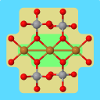Molcas Forum
Support and discussions for Molcas and OpenMolcas users and developers
You are not logged in.
- Topics: Active | Unanswered
Announcement
Please note: The forum's URL has changed. The new URL is: https://molcasforum.univie.ac.at. Please update your bookmarks!
You can choose an avatar and change the default style by going to "Profile" → "Personality" or "Display".Pages: 1
#1 2018-04-29 22:55:16
- tumitumi123
- Member
- Registered: 2017-06-13
- Posts: 16
Problems in orbital optimization CASSCF
dear all,
I am studying Br2. I try to visualize Br atom orbital. But there is warning of orbital optimization during casscf.
I also saw this problem in my earlier post for CH3I at large CI bond. I really want to know why it always don't work and how to solve this problem. Below is the warning and my input.
###############################################################################
###############################################################################
### ###
### ###
### Problems in orbital optimization. ###
### ###
### ###
###############################################################################
###############################################################################
Warning: In symmetry 1, orbital p= 10 has diagonal density matrix element D(p,p) close to two. (2 - D(p,p))= -0.133227D-14&gateway
coord
1
bohr
BR 0 0 0
basis=aug-cc-pvtz
group=nosymm
&SEWARD
&scf
&RASSCF
spin=2
nactel=17 0 0
inactive=9
ras2=9
ciroot=1 1 1
symmetry=1
&GRID_ITEven sometimes it works by changing active and inactive orbital. the order of orbital is not right. It gives me 3d4s4p, but the correct one is 4s3d4p.
what can I do with the orbital optimization problem??
Offline
#2 2018-04-30 11:19:06
- nikolay
- Member

- From: Stuttgart
- Registered: 2016-03-21
- Posts: 55
Re: Problems in orbital optimization CASSCF
The warning says that you include a doubly-occupied orbital in the active space.
Implying that it could be excluded into inactive.
But the optimization is still finished with 'happy landing'.
The final orbital ordering is done according to natural orbitals occupation.
Offline
#3 2018-04-30 15:32:30
- Ignacio
- Administrator

- From: Uppsala
- Registered: 2015-11-03
- Posts: 1,165
Re: Problems in orbital optimization CASSCF
In other words, the warning is a warning, not an error. If the final result it's converged to the "right" active space, there's probably nothing to worry about. As nikolay says, the order is by (average) occupation, not by energy (which is not well-defined for active natural orbitals), so if it's not what you expect, either your expectation was wrong or you should reconsider your active space and state averaging...
Offline
#4 2018-04-30 17:18:51
- tumitumi123
- Member
- Registered: 2017-06-13
- Posts: 16
Re: Problems in orbital optimization CASSCF
The warning says that you include a doubly-occupied orbital in the active space.
Implying that it could be excluded into inactive.
But the optimization is still finished with 'happy landing'.
The final orbital ordering is done according to natural orbitals occupation.
Thanks, nikolay and ignacio
since I only calculate one state, are natural orbitals identical with average orbitals?
Is the orbital still the optimized orbital after casscf?
and how can i check the energy of the orbital to make sure that it is right in energy(if it is not well-defined for active natural orbitals).
So is it right if I stateaverage more state, the orbital (output by rasorb) will change the shape or order? because it averages over all the state?
Offline
#5 2018-04-30 18:51:20
- tumitumi123
- Member
- Registered: 2017-06-13
- Posts: 16
Re: Problems in orbital optimization CASSCF
************************************************************************************************************************
Wave function printout:
occupation of active orbitals, and spin coupling of open shells (u,d: Spin up or down)
************************************************************************************************************************
Note: transformation to natural orbitals
has been made, which may change the order of the CSFs.
printout of CI-coefficients larger than 0.05 for root 1
energy= -2572.086864
conf/sym 111111111 Coeff Weight
2 222222u20 -0.99787 0.99575
Natural orbitals and occupation numbers for root 1
sym 1: 1.999988 1.999990 1.999893 1.999999 1.999562 1.996037 1.000022 1.996026 0.008483to make it clear, is the orbital in "222222u20" the orbital output by rasorb file(visualized by grid_it)?
"Natural orbitals and occupation numbers for root 1" this is the real natural orbital for root 1 output by rasorb.1 ?
Is there a way I can know the energy of the active orbital? so I can know the right order when geometry changes?
Offline
#6 2018-05-02 12:46:46
- Ignacio
- Administrator

- From: Uppsala
- Registered: 2015-11-03
- Posts: 1,165
Re: Problems in orbital optimization CASSCF
Actually, I have to take back my statement, the orbitals are obviously not ordered by occupation. In fact, the order is completely arbitrary, depending on the order of the starting orbitals and how the optimization proceeds.
As for your questions, yes, with one state the natural orbitals are the same as the average (natural) orbitals. The CSF identification you see (222222u20) corresponds to the average natural orbitals (the RasOrb file, if you didn't any option to change it). The "Natural orbitals and occupation numbers", however, correspond to the state-specific natural orbitals (the RasOrb.x files). In your case, with only one state, these are the same and the distinction does not matter.
Since the order is arbitrary, you should not draw any conclusion from the order of the orbitals. If you want to compare something, you can order them yourself by occupation (I don't know of any way to obtain meaningful energies for these orbitals, but you could use OUTO to get canonical orbitals, with energies but without occupations). In this case the order would be: 4, 2, 1, 3, 5, 6, 8, 7, 9
Offline
Pages: 1
